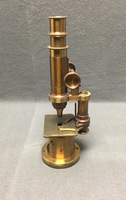Items
Description is exactly
The drum-style compound microscope is crafted from brass and stands on a lead-weighted circular base. The designer of the instrument, Georg Johann Oberhaeuser (1798-1868) established a microscope-making business in Paris in the 1830s. The instrument is signed "G. Oberhaeuser, Place Dauphine, Paris" on the body tube. Due to the drum-style design, the substage mirror sits in a cylinder compartment with a square cut-out, by which the light can reach the mirror. On either side of the compartment are small thumbscrews that allow the position of the mirror to be adjusted. Above the mirror is a wheel of apertures mounted to the stage that can be rotated to control the amount of light that reaches the specimen. The square stage has two stage clips to hold slides in place. The column pillar connects the stage to the body tube. Another aspect of this design is that the microscope cannot be angled and so must stand completely straight when being used. Coarse focusing is, unusually, by a rack and pinion mechanism. The style usually included a sliding mechanism for focusing, and so this instrument may have been a custom order. The two threaded holes in the base suggest that the microscope was mounted to a desk for industrial or scientific use.
-

Oberhaeuser Drum Microscope
c. 1830-1854
